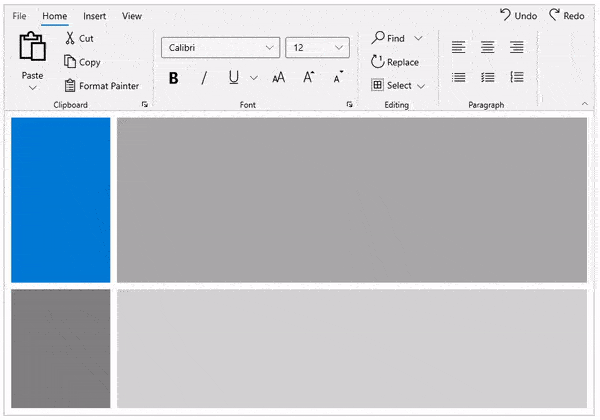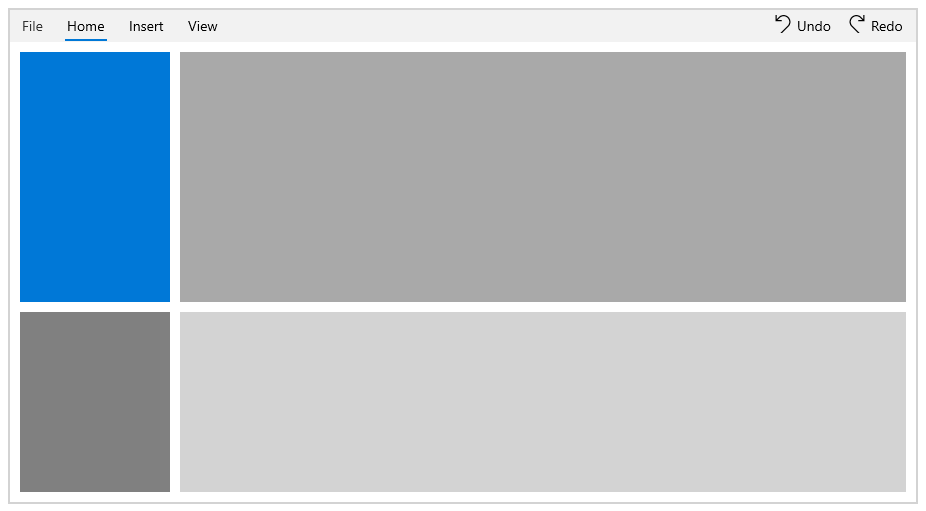Simplified Layout in WinUI Ribbon Control
22 Jan 202515 minutes to read
The Syncfusion® Ribbon provides a compact and simplified layout by arranging the most-used commands in a single line, occupying less space. Quickly navigate to other commonly used commands in the overflow menu, and then switch to normal mode using the built-in toggle button. This section explains in detail about the simplified layout.
Enabling simplified layout
The LayoutModeOptions enumeration property provides an option to enable Simplified layout in Ribbon control. The LayoutModeOptions is of flag enumeration type that contains the following values:
- Normal - The Ribbon items are arranged in the standard layout.
- Simplified - The Ribbon items are arranged in the single line layout.
It also contains the following combination like:
- Normal, Simplified - The Ribbon items are arranged both in Normal and Simplified layout. This is the default value.
To load the Ribbon control in simplified layout, ActiveLayoutMode enumeration property can be used. It contains the following values:
- Normal - Display the Ribbon in standard layout at startup. This is the default value.
- Simplified - Display the Ribbon in single line layout at startup.
<Page
<Grid x:Name="rootGrid">
<ribbon:SfRibbon x:Name="sfRibbon"
ActiveLayoutMode="Simplified"
LayoutModeOptions="Simplified">
</ribbon:SfRibbon>
</Grid>
</Page>public sealed partial class MainPage : Page
{
public MainPage()
{
this.InitializeComponent();
SfRibbon sfRibbon = new SfRibbon();
sfRibbon.LayoutModeOptions = LayoutModeOptions.Simplified;
sfRibbon.ActiveLayoutMode = LayoutMode.Simplified;
rootGrid.Children.Add(sfRibbon);
}
}
Switching between normal and simplified layouts
The Ribbon control allows to switch between simplified and normal layouts at the runtime using the toggle button located in the lower right corner of the Ribbon. To enable this option, set the LayoutModeOptions to “Normal,Simplified” as given in the below layout.
<Page
<Grid x:Name="rootGrid">
<ribbon:SfRibbon x:Name="sfRibbon"
LayoutModeOptions="Normal,Simplified">
</ribbon:SfRibbon>
</Grid>
</Page>public sealed partial class MainPage : Page
{
public MainPage()
{
this.InitializeComponent();
SfRibbon sfRibbon = new SfRibbon();
sfRibbon.LayoutModeOptions = LayoutModeOptions.Normal | LayoutModeOptions.Simplified;
rootGrid.Children.Add(sfRibbon);
}
}}

Visibility of ribbon items between normal and simplified layouts
The Ribbon items can be set commonly between different layouts or can be made visible only in a particular layout using the DisplayOptions property. By default, items will be displayed in both normal and simplified layout. The DisplayMode is of flag enumeration type that contains the following values.
- Normal - The item will be displayed only in the normal layout.
- Simplified - The item will be displayed only in the simplified layout.
- OverflowMenu - The item will be displayed only inside the overflow menu when simplified layout is enabled.
Also, the DisplayMode property allows the following value combinations as well.
- Normal, Simplified – The item will be displayed in both normal and simplified layout.
- Normal, OverflowMenu – The item will be displayed in both normal layout and inside overflow menu during simplified layout.
- Simplified, OverflowMenu – The item will be displayed in simplified layout.
- Normal, Simplified, OverflowMenu – The item will be displayed in both normal and simplified layout.
<Page
<!--This item will be displayed in normal and simplified layout-->
<ribbon:RibbonSplitButton Command="{Binding ButtonCommand}"
CommandParameter="Paste"
Content="Paste"
DisplayOptions="Normal,Simplified"
Icon="Paste"
SizeMode="Large">
</ribbon:RibbonSplitButton>
<!--This item will be displayed in normal layout and inside overflow menu during simplified Layout-->
<ribbon:RibbonButton Command="{Binding ButtonCommand}"
CommandParameter="Cut"
Content="Cut"
DisplayOptions="Normal,Overflow"
Icon="Cut"
SizeMode="Normal" />
<!--This item will be displayed only in simplified layout-->
<ribbon:RibbonButton Command="{Binding ButtonCommand}"
CommandParameter="Copy"
Content="Copy"
DisplayOptions="Simplified"
Icon="Copy"
SizeMode="Normal" />
<!--This item will be displayed only in normal layout-->
<ribbon:RibbonButton Command="{Binding ButtonCommand}"
CommandParameter="Format Painter"
Content="Format Painter"
DisplayOptions="Normal"
SizeMode="Normal"/>
</Page>//This item will be displayed in normal and simplified layout
RibbonSplitButton pasteButton = new RibbonSplitButton();
pasteButton.Content = "Paste";
pasteButton.Icon = new SymbolIcon(Symbol.Paste);
pasteButton.DisplayOptions = DisplayOptions.Normal | DisplayOptions.Simplified;
//This item will be displayed in normal layout and inside overflow menu during simplified Layout
RibbonButton cutButton = new RibbonButton();
cutButton.Content = "Cut";
cutButton.Icon = new SymbolIcon(Symbol.Cut);
cutButton.DisplayOptions = DisplayOptions.Normal | DisplayOptions.Overflow;
//This item will be displayed only in simplified layout-->
RibbonButton copyButton = new RibbonButton();
copyButton.Content = "Copy";
copyButton.Icon = new SymbolIcon(Symbol.Copy);
copyButton.DisplayOptions = DisplayOptions.Simplified;
//This item will be displayed only in normal layout-->
RibbonButton formatButton = new RibbonButton();
formatButton.Content = "Cut";
formatButton.Icon = new SymbolIcon(Symbol.SyncFolder);
formatButton.DisplayOptions = DisplayOptions.Normal;
}}

Customizing overflow menu
Overflow menu can be enabled either at the end of each RibbonGroup or placed at the end of content area. This can be customized using OverflowItemDisplayMode property. It contains two values,
- TabLevel - Group the overflow menu at the end of content area. This is the default value.
- GroupLevel - Group the overflow menu at the end of
RibbonGroup.
<Page
<ribbon:RibbonGroup Header="Font"
OverflowItemDisplayMode="GroupLevel" />
</Page>RibbonGroup ribbonGroup = new RibbonGroup();
ribbonGroup.Header = "Font";
ribbonGroup.OverflowItemDisplayMode = OverFlowItemDisplayMode.GroupLevel;
Display mode
Syncfusion® Ribbon control provides a minimized and adorner state. Enable the AllowMinimize property to toggle between normal and minimized state.
<Page
<ribbon:SfRibbon x:Name="ribbon"
AllowMinimize="True">
</ribbon>
</Page>public sealed partial class MainPage : Page
{
public MainPage()
{
this.InitializeComponent();
SfRibbon sfRibbon = new SfRibbon();
sfRibbon.AllowMinimize = true;
rootGrid.Children.Add(sfRibbon);
}
}Switching between normal and minimized state
The Ribbon control allows to switch between normal and minimized state at the runtime using the toggle button located in the lower right corner of the Ribbon. To Switch, double click on the RibbonTab. To enter into the adorner state, single click on RibbonTab.
N When simplified mode is enabled, toggle button is used to switch between normal and simplified layout. In that case, use the
RibbonTabdouble click option to enter into minimized state.

Loading in minimized state
The Ribbon control allows to load in minimized state by using IsMinimized property. By enabling this property, the Ribbon is loaded in minimized state.
<Page
<ribbon:SfRibbon x:Name="ribbon"
AllowMinimize="True"
IsMinimized = "True">
</ribbon>
</Page>public sealed partial class MainPage : Page
{
public MainPage()
{
this.InitializeComponent();
SfRibbon sfRibbon = new SfRibbon();
sfRibbon.AllowMinimize = true;
sfRibbon.IsMinimized = true;
rootGrid.Children.Add(sfRibbon);
}
}